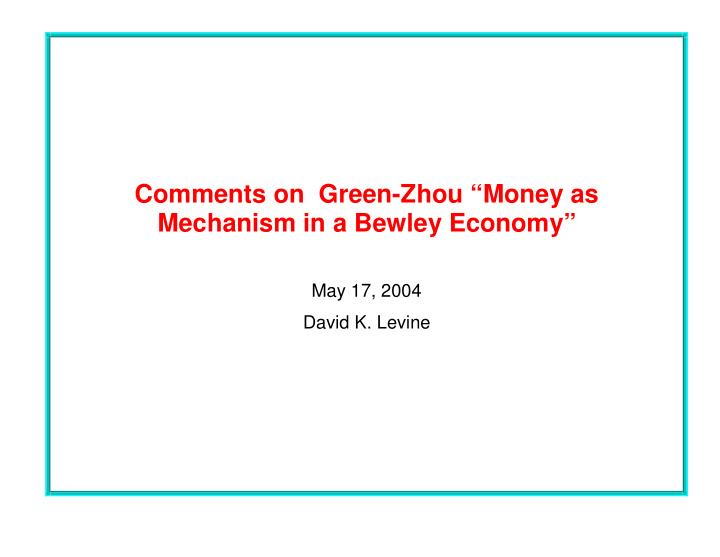



Comments on Green-Zhou “Money as Mechanism in a Bewley Economy” May 17, 2004 David K. Levine
The Model dynamic pure exchange continuum economy with no aggregate risk individuals face private iid shocks �� � perishable endowment � � � � , utility � � � � � � , discount factor � a single consumption good 1
The Mechanisms � delivered to planner �� � � message sent to planner � �� � � information available to planner about � � �� note one dimensional nature of message and planner information essentially forces “one kind of money” cannot address the question – could we do significantly better by using two kinds of money; or money and some other type of credit mechanism? � delivery from planner to trader �� traders do not observe deliveries between other traders and planner 2
laissez faire monetary mechanism competitive mechanism with fiat money/trading post basic pricing mechanism: price is nominal demand divided by real supply � � � � � � � � � � � � � � wealth and consumption are augmented accordingly � � � � � �� �� �� � � � � � � � � � � � �� �� � � �� �� expansionary/contractionary mechanisms: nominal money balances inflate/deflate at constant rate with equal per capita lump sum seignorage distribution 3
Equilibrium symmetric stationary Markov existence in laissez faire monetary case showing that the solution to the “one-person free storage” problem is isomorphic to an equibrium [note absence of aggregate shocks] 4
near efficiency means “nearly first best in per period consumption units” note some problematic aspects of using “efficiency” in this mechanism design setting as “near efficiency” [permanent income hypothesis] � � � 5
example 6.1: nonmonetary dominates laissez faire monetary locally linear preferences with satiation two state 50-50 first best: satiate high marginal utility people, give rest to low marginal utility improved on by having zero money low MU give small amount to zero money high MU [follows from existence of zero money high MU types] question: is this impossible with expansionary monetary? 6
example 6.2: expansionary dominate laissez faire monetary same as previous example, but non-binding satiation locally linearity gives expansionary first best [pareto improvement on laissez faire is more robust – doesn’t require linearity] 7
Recommend
More recommend